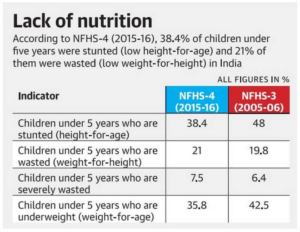In news
NITI Aayog finds challenges and gives some recommendations for transforming nutrition in India
Key findings and recommendations of the report
- It is the NITI Aayog’s third progress report on the Nutrition Mission.
- According to NITI Aayog Poshan Abhiyan must be stepped up in order to meet the targets set by the Centre to reduce stunting, wasting, and anaemia by 2022
- The report was drafted in March and does not factor worsening poverty and hunger levels over the past seven months
- To state the emerging challenges like micronutrient deficiencies, and the cross-cutting challenges of urbanization and of growing overweight and obesity.
- Deeply investing in improving dietary quality – through a primary focus on dietary diversity and diet quality – will help achieve multiple nutrition goals.
- In addition, following the path already laid out on fortification of key staples will help mitigate, at least partially, some micronutrient deficiencies.
- As per the report, the focus of work on urban nutrition must go well beyond catering to the challenges of the urban poor and must engage stakeholders across the board to address issues of overweight and obesity as well.
- It states that “we need to quickly graduate to a POSHAN-plus strategy which apart from continued strengthening the four pillars of the Abhiyaan also requires renewed focus on other social determinants in addition to addressing the governance challenges of NHM/ ICDS delivery mechanisms”
- On stunting:
- The report calls for a need to lay as much emphasis on complementary feeding as it does on breastfeeding, which it points out can help avert 60% of the total stunting cases in India.
- It also recommends improved “water, sanitation, hand washing with soap and hygienic disposal of children’s stools” as other interventions which could help avert a quarter of the stunting cases.
- The review says that India’s targets are conservative as compared to the global target defined by the World Health Assembly (WHA), which is a prevalence rate of 5% of stunting as opposed to India’s goal of reducing stunting levels to 13.3% by 2022.
- It says that additional preventive nutrition and health sensitive strategies are required to achieve further reductions in wasting to meet WHA target for India
- On Anaemia:
- The target of reducing anaemia among pregnant women from 50.3% in 2016 to 34.4% in 2022 and among adolescent girls from 52.9% in 2016 to 39.66%, is also considered to be conservative as compared to the WHA’s target of halving prevalence levels.
- It notes that the government must implement interventions beyond the health sector and its focus on distribution of IFA tablets, and must include efforts to improve socio-economic conditions, else India will “achieve modest improvements in anaemia” among women of reproductive age.
- On Wasting:
- The LiST model suggested including interventions that go beyond the treatment of severe acute malnutrition (SAM) and include those that also address moderate wasting, have the potential to achieve larger declines in wasting than by tackling SAM alone.
- Facility-based treatment of SAM, implemented by the MoHFW, needs to scale-up to reach all those needing in-patient care
National Family Health Survey-4
- More than a third of children under five suffer from stunting and wasting and 40% of children between one and four are anaemia
- Over 50% of pregnant and non-pregnant women were found to be anaemic, according to the National Family Health Survey-4 released in 2016.

About Poshan Abhiyan
- It is the world’s largest nutrition programme for children and mothers
- It is the Union government’s flagship programme to improve nutritional outcomes for children, pregnant women and lactating mothers was launched in 2018 with specific targets to be achieved by 2022.
- It aims to reduce stunting and wasting by 2% per year (total 6% until 2022) among children and anaemia by 3% per year (total 9% until 2022) among children, adolescent girls and pregnant women and lactating mothers.
- The acronym POSHAN (PM’s Overarching Scheme for Holistic Nourishment) spelt the Government’s commitment to tackle the issue of malnutrition with well-defined policies and support from the highest level.
- The programme also aims to ensure service-delivery and interventions by using technology, behavioural change through convergence and lays down specific targets to be achieved across different monitoring parameters over the next few years
















